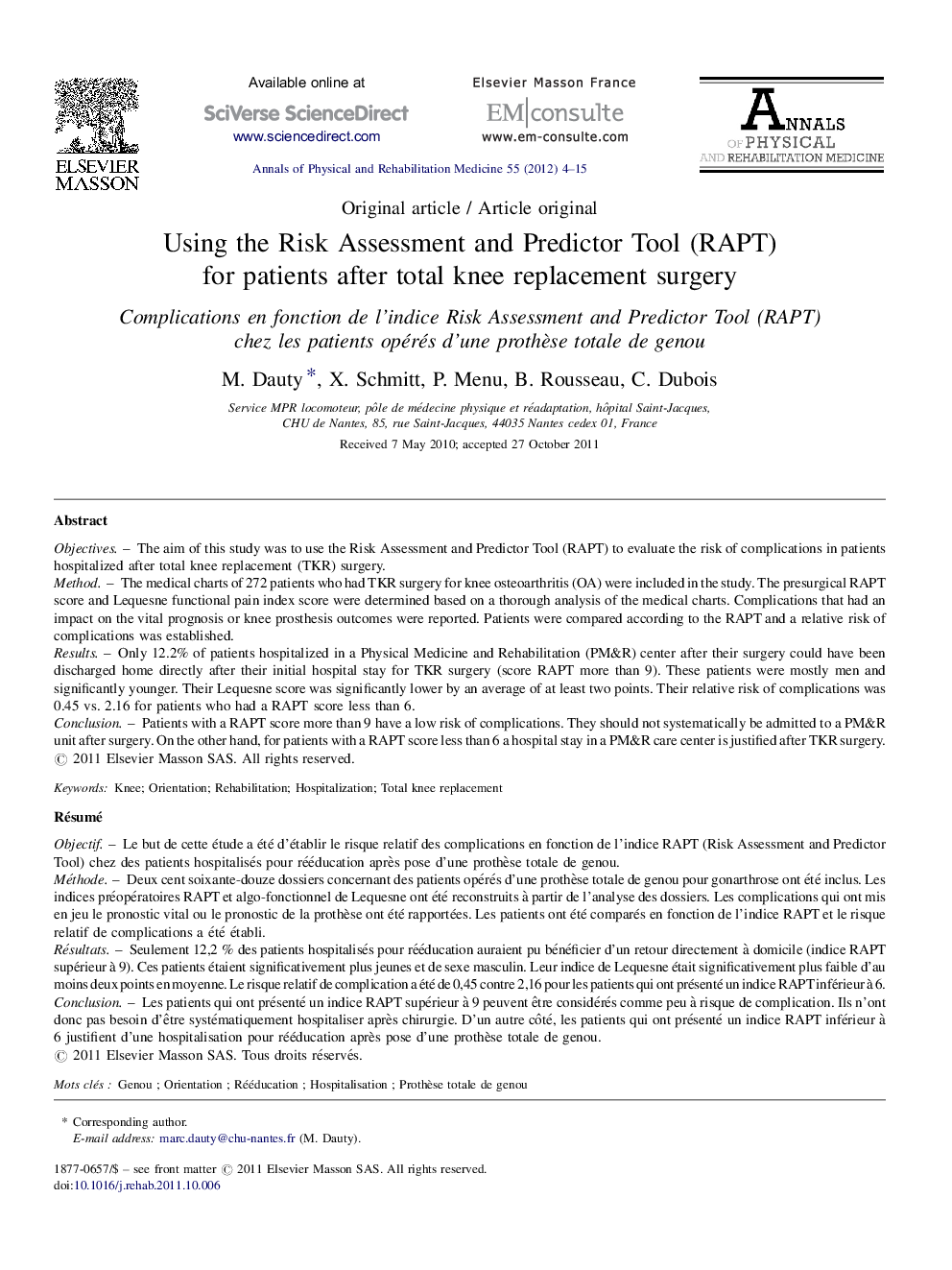| کد مقاله | کد نشریه | سال انتشار | مقاله انگلیسی | نسخه تمام متن |
|---|---|---|---|---|
| 4041220 | 1603330 | 2012 | 12 صفحه PDF | دانلود رایگان |

ObjectivesThe aim of this study was to use the Risk Assessment and Predictor Tool (RAPT) to evaluate the risk of complications in patients hospitalized after total knee replacement (TKR) surgery.MethodThe medical charts of 272 patients who had TKR surgery for knee osteoarthritis (OA) were included in the study. The presurgical RAPT score and Lequesne functional pain index score were determined based on a thorough analysis of the medical charts. Complications that had an impact on the vital prognosis or knee prosthesis outcomes were reported. Patients were compared according to the RAPT and a relative risk of complications was established.ResultsOnly 12.2% of patients hospitalized in a Physical Medicine and Rehabilitation (PM&R) center after their surgery could have been discharged home directly after their initial hospital stay for TKR surgery (score RAPT more than 9). These patients were mostly men and significantly younger. Their Lequesne score was significantly lower by an average of at least two points. Their relative risk of complications was 0.45 vs. 2.16 for patients who had a RAPT score less than 6.ConclusionPatients with a RAPT score more than 9 have a low risk of complications. They should not systematically be admitted to a PM&R unit after surgery. On the other hand, for patients with a RAPT score less than 6 a hospital stay in a PM&R care center is justified after TKR surgery.
RésuméObjectifLe but de cette étude a été d’établir le risque relatif des complications en fonction de l’indice RAPT (Risk Assessment and Predictor Tool) chez des patients hospitalisés pour rééducation après pose d’une prothèse totale de genou.MéthodeDeux cent soixante-douze dossiers concernant des patients opérés d’une prothèse totale de genou pour gonarthrose ont été inclus. Les indices préopératoires RAPT et algo-fonctionnel de Lequesne ont été reconstruits à partir de l’analyse des dossiers. Les complications qui ont mis en jeu le pronostic vital ou le pronostic de la prothèse ont été rapportées. Les patients ont été comparés en fonction de l’indice RAPT et le risque relatif de complications a été établi.RésultatsSeulement 12,2 % des patients hospitalisés pour rééducation auraient pu bénéficier d’un retour directement à domicile (indice RAPT supérieur à 9). Ces patients étaient significativement plus jeunes et de sexe masculin. Leur indice de Lequesne était significativement plus faible d’au moins deux points en moyenne. Le risque relatif de complication a été de 0,45 contre 2,16 pour les patients qui ont présenté un indice RAPT inférieur à 6.ConclusionLes patients qui ont présenté un indice RAPT supérieur à 9 peuvent être considérés comme peu à risque de complication. Ils n’ont donc pas besoin d’être systématiquement hospitaliser après chirurgie. D’un autre côté, les patients qui ont présenté un indice RAPT inférieur à 6 justifient d’une hospitalisation pour rééducation après pose d’une prothèse totale de genou.
Journal: Annals of Physical and Rehabilitation Medicine - Volume 55, Issue 1, February 2012, Pages 4–15